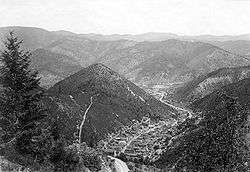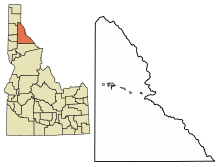Wardner, Idaho
Wardner is a city in Shoshone County, Idaho, United States. Located in the Silver Valley mining region, the population was 188 at the 2010 census, down from 215 in 2000.
Wardner, Idaho | |
|---|---|
 Wardner in 1904 (foreground), separated from Kellogg (middle ground), by the conical hill called Haystack Peak[2] | |
 Location of Wardner in Shoshone County, Idaho. | |
| Coordinates: 47°31′23″N 116°8′3″W | |
| Country | United States |
| State | Idaho |
| County | Shoshone |
| Government | |
| • Mayor | Jo Ann Groves |
| Area | |
| • Total | 0.87 sq mi (2.26 km2) |
| • Land | 0.87 sq mi (2.26 km2) |
| • Water | 0.00 sq mi (0.00 km2) |
| Elevation | 2,657 ft (810 m) |
| Population | |
| • Total | 188 |
| • Estimate (2019)[5] | 176 |
| • Density | 201.83/sq mi (77.95/km2) |
| Time zone | UTC-8 (Pacific (PST)) |
| • Summer (DST) | UTC-7 (PDT) |
| ZIP code | 83837 |
| Area code(s) | 208, 986 |
| FIPS code | 16-85240 |
| GNIS feature ID | 0400161 |
| Website | www |
Geography
Wardner is located at 47°31′23″N 116°8′3″W (47.523164, -116.134190),[6] at an elevation of 2,657 feet (810 m) above sea level.
According to the United States Census Bureau, the city has a total area of 0.86 square miles (2.23 km2), all of it land.[7]
History
The city was named for Jim Wardner,[8] an early promoter of the Bunker Hill and Sullivan mine in the 1880s and a seller of corner lots in the city. Born in Wisconsin in 1846, he held various occupations in Arizona, California, Utah, Wisconsin, South Dakota, and Washington state. After his time in the Silver Valley of Idaho, he followed the mining booms to South Africa, British Columbia, and the Klondike; he published his autobiography in 1900 and died in El Paso, Texas in 1905.[9][10]
In 1892, and again in 1899, angry union miners converged on the Bunker Hill mine during confrontations with mine owners.
Hard rock miners in Shoshone County protested wage cuts with a strike in 1892. After several lost their lives in a shooting war provoked by discovery of a company spy, the U.S. army forced an end to the strike. Hostilities erupted once again in 1899 when, in response to the company firing seventeen men for joining the union, the miners dynamited the Bunker Hill & Sullivan mill. Again, lives were lost, and the army intervened.
The gondola for the Silver Mountain ski resort passes over the town.
Demographics
| Historical population | |||
|---|---|---|---|
| Census | Pop. | %± | |
| 1910 | 1,369 | — | |
| 1920 | 704 | −48.6% | |
| 1930 | 903 | 28.3% | |
| 1940 | 861 | −4.7% | |
| 1950 | 772 | −10.3% | |
| 1960 | 577 | −25.3% | |
| 1970 | 492 | −14.7% | |
| 1980 | 423 | −14.0% | |
| 1990 | 246 | −41.8% | |
| 2000 | 215 | −12.6% | |
| 2010 | 188 | −12.6% | |
| Est. 2019 | 176 | [5] | −6.4% |
| U.S. Decennial Census[11] | |||
2010 census
At the 2010 census there were 188 people in 75 households, including 60 families, in the city. The population density was 218.6 inhabitants per square mile (84.4/km2). There were 118 housing units at an average density of 137.2 per square mile (53.0/km2). The racial makup of the city was 95.2% White, 1.1% Native American, 1.6% Asian, 0.5% from other races, and 1.6% from two or more races. Hispanic or Latino of any race were 2.7%.[4]
Of the 75 households 29.3% had children under the age of 18 living with them, 60.0% were married couples living together, 8.0% had a female householder with no husband present, 12.0% had a male householder with no wife present, and 20.0% were non-families. 16.0% of households were one person and 5.3% were one person aged 65 or older. The average household size was 2.51 and the average family size was 2.62.
The median age was 46 years. 20.2% of residents were under the age of 18; 7.5% were between the ages of 18 and 24; 20.8% were from 25 to 44; 35.1% were from 45 to 64; and 16.5% were 65 or older. The gender makeup of the city was 51.6% male and 48.4% female.
2000 census
At the 2000 census there were 215 people in 88 households, including 60 families, in the city. The population density was 251.1 people per square mile (96.5/km2). There were 111 housing units at an average density of 129.6 per square mile (49.8/km2). The racial makup of the city was 95.81% White, 0.47% Native American, 0.47% Pacific Islander, 1.40% from other races, and 1.86% from two or more races. Hispanic or Latino of any race were 2.33%.[12]
Of the 88 households 25.0% had children under the age of 18 living with them, 50.0% were married couples living together, 9.1% had a female householder with no husband present, and 31.8% were non-families. 25.0% of households were one person and 15.9% were one person aged 65 or older. The average household size was 2.44 and the average family size was 2.85.
The age distribution was 24.7% under the age of 18, 7.4% from 18 to 24, 24.7% from 25 to 44, 30.2% from 45 to 64, and 13.0% 65 or older. The median age was 42 years. For every 100 females, there were 104.8 males. For every 100 females age 18 and over, there were 105.1 males.
The median household income was $25,500 and the median family income was $31,563. Males had a median income of $36,071 versus $21,250 for females. The per capita income for the city was $14,051. About 14.0% of families and 12.8% of the population were below the poverty line, including 3.8% of those under the age of eighteen and 6.5% of those sixty five or over.

See also
- Silver Valley
- Silver Mountain - ski resort
References
- Ransome, Frederick; Calkins, Frank (1908). The geology and ore deposits of the Coeur d'Alene district, Idaho, USGS Professional Paper 62. Washington: U.S. Dept. of the Interior, USGS, Government Printing Office. p. 22. Retrieved 21 November 2018.
- Ransome, Frederick; Calkins, Frank (1908). The geology and ore deposits of the Coeur d'Alene district, Idaho, USGS Professional Paper 62. Washington: U.S. Dept. of the Interior, USGS, Government Printing Office. p. 22. Retrieved 21 November 2018.
- "2019 U.S. Gazetteer Files". United States Census Bureau. Retrieved July 9, 2020.
- "U.S. Census website". United States Census Bureau. Retrieved 2012-12-18.
- "Population and Housing Unit Estimates". United States Census Bureau. May 24, 2020. Retrieved May 27, 2020.
- "US Gazetteer files: 2010, 2000, and 1990". United States Census Bureau. 2011-02-12. Retrieved 2011-04-23.
- "US Gazetteer files 2010". United States Census Bureau. Retrieved 2012-12-18.
- "Folklore Refuted by Early Settler". The Spokesman-Review. 18 October 1965. p. 5. Retrieved 23 April 2015.
- "Profile for Wardner, Idaho". ePodunk. Retrieved 2010-05-28.
- "Idaho for the Curious", by Cort Conley, ©1982, ISBN 0-9603566-3-0, Backeddy, p.471-473
- "Census of Population and Housing". Census.gov. Retrieved June 4, 2015.
- "U.S. Census website". United States Census Bureau. Retrieved 2008-01-31.
External links
- YouTube.com - video - powder skiing into Wardner, Idaho - 2008-02
- City of Wardner Homepage
Further reading
- Report of the Miners' strike in the State of Idaho. Annual Reports of the Secretary of War By United States War Dept 1899. pp. 28–74. Google Books
- Wardner, Jim. Jim Wardner of Wardner Idaho. New York: Anglo-American Publishing Co. Internet Archive